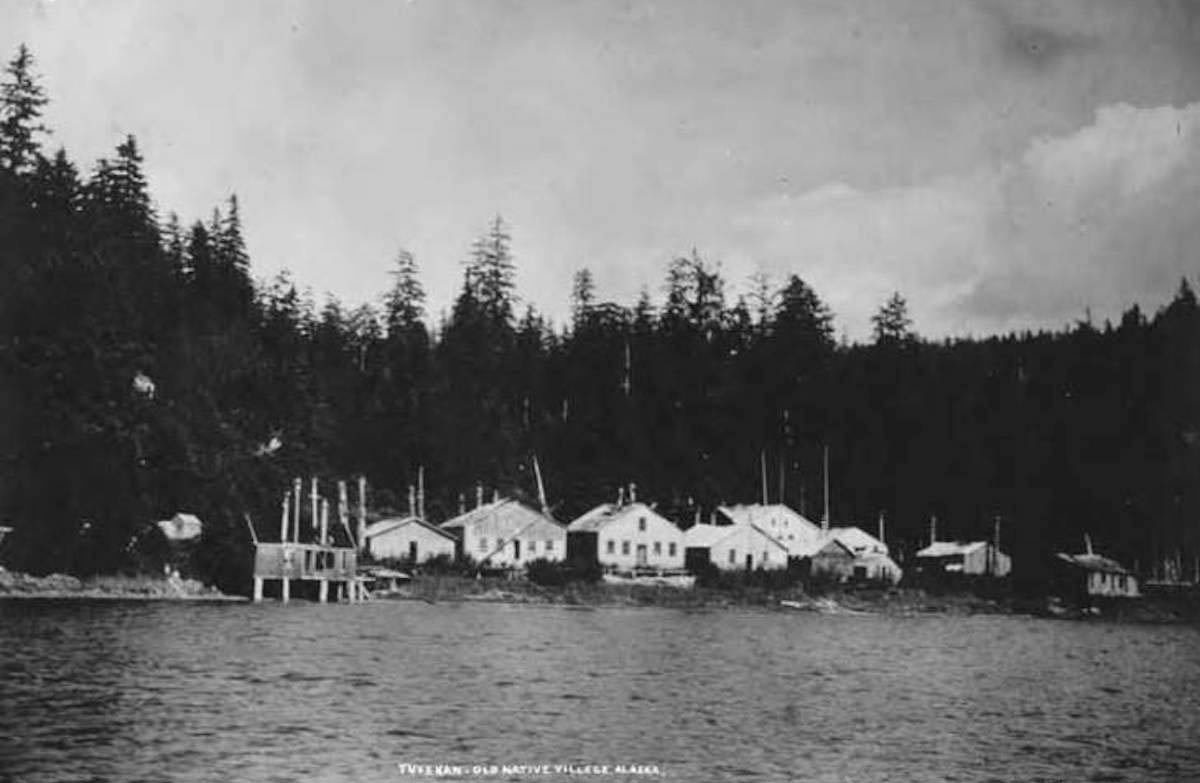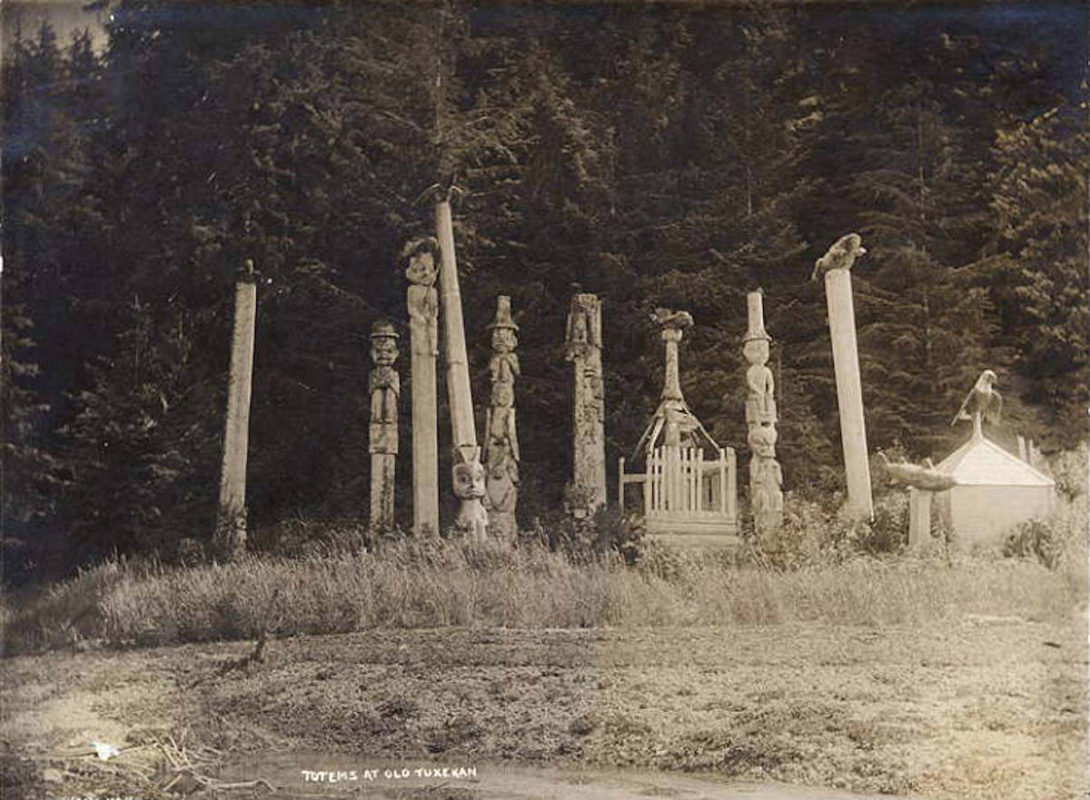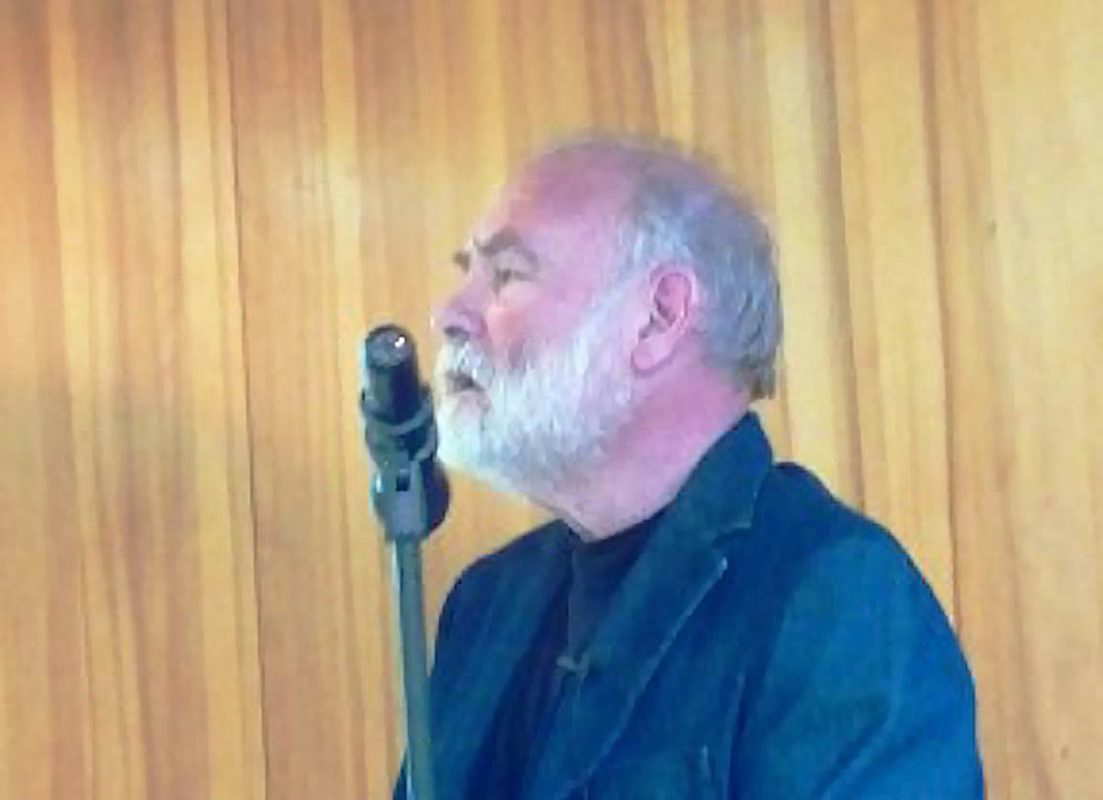
The Tlingit (pronounced klink-it) have lived in southeastern Alaska for over ten thousand years and their territory expanded further down the west coast of North America. However, the incursion of 19th-century colonizers resulted in the occupation of their land and the theft of their cultural objects and heritage. One of the most famous crimes was committed by actor John Barrymore in 1931 when he stole a Tlingit totem pole.
History Of The Tlingit In Alaska

As the northernmost of the Northwest Coast Indigenous peoples, at one time their territory encompassed the Alaskan panhandle as well as the Alexander Archipelago. The Tlingit thrived as a semi-sedentary hunter-gatherer society that also participated in a vast trading network that stretched as far south as present-day California. The Tlingit’s command over their region’s waterways (the name “Tlingit” actually translates to “People of the Tides”) eventually helped them to fend off incursions from Russian troops in the late 1700s. As more colonizers flooded the area during the 19th century, the Tlingit exercised their sovereignty over the waters by charging European traders for passage through their land and also selling newcomers meat, fish, and potatoes.

Most Tlingit social customs stemmed from the group’s unique kinship system. All Tlingit peoples were divided between two moieties or descent groups. Each moiety was further broken up into different lineages, all of which were passed down through the maternal land. Although all the Tlingit were united by a shared language and lifestyle, each lineage operated more or less autonomously, with members forming individual settlements with their own leaders and political operations. At the Tlingit population’s height, there are about eighty lineages total. Each lineage had its own heraldic crest featuring different animals; the crests’ designs were carefully considered in order to communicate one’s status, wealth and reputation. As such, they were emblazoned on everything from shelters and canoes to forks, knives, and other tools.
Totem Poles Are An Important Element Of Indigenous Culture

Get the latest articles delivered to your inbox
Sign up to our Free Weekly NewsletterThanks in part to their region’s abundant natural resources, the Tlingit have an extensive craft history that incorporates shells, stones, metals, wood, and other materials. One significant art object that the Tlingit shared with other northwest indigenous peoples was the totem pole. Often towering over 30 feet high, these vivid painted logs featured are enlivened with carvings of animals and spirits. Each animal and spirit are symbols that, when featured in a particular sequence on the pole, communicate a particular story of meaning.

In Tlingit culture, totem poles were most often carved in the design of lineage crests. Tlingit artisans favored the suppleness of Western red cedar logs, which they subsequently stripped of bark and hollowed out on one side. After the carving was finished, the poles were painted in black, red, and bluish green using porcupine hair brushes; once the paint dried, the poles were sealed with whale fat. Every detail, from pole’s height to the vividness of its colors, was carefully considered as an indicator of the commissioner’s status. The finished products were lauded at pole-raising celebrations, during which they were erected in their final position in front of a home, along territorial borders and shorelines, or as mortuary monuments for human remains. A key part of the totem pole tradition is that the poles were never moved, but rather left to weather and eventually give way to the elements in their original resting place.
The Village Of Tuxekan Was Home To An Impressive Array Of Totems

In the late 19th century, the Tlingit totem pole tradition was perhaps nowhere more in evidence than the village of Tuxekan. A thriving winter settlement huddled against the shoreline on Prince Edward Island, Tuxekan was once home to approximately 142 totem poles. Accounts from former villages along with scholarship based on a 1938-40 restoration project by the Civilian Conservation Corps (CCC) confirmed that all of the village’s poles were commemorative objects for human remains or gravesites. Although these totems were simpler and not as tall as most Tlingit carvings, their long shadows across the village and onto the water nonetheless made a majestic sight.

Sadly, the construction of the Tuxekan totem pole “forest” coincided with the most difficult period in Tlingit history. Like other indigenous groups, the Tlingit incurred terrible losses in the face of genocide and discrimination by white settlers. By the mid-1800s, for example, over half the population had succumbed to disease. Dwindling numbers combined with the encroachment of logging and mining industries on Native land forced many Tlingit to abandon their villages in favor of nearby cities. By 1900, most of Tuxekan’s own residents had left for the town of Klawock, where a canning plant promised jobs and hope for survival. As overgrowth began to ensnare the abandoned plank houses and canoe runs, the Tuxekan totem poles held their ground between the trees, weathering the new century in eerie silence. Three decades on, it was the sight of these proud, melancholy monuments that drew a Hollywood icon to Tuxekan’s shores.
John Barrymore Was A Star With An Appetite For Pilfered “Curiosities”

Remembered today as a pillar of one of America’s greatest acting families, in the summer of 1931 John Barrymore was basking in the glow of a whirlwind decade. The son of two successful theater performers, Barrymore’s own two decades on stage culminated in 1922 with his titular performance in Hamlet. The success of his turn as the doomed Danish prince eventually led to a contract with Warner Bros. and a lucrative career in silent films. Riding high off the success of his latest role in Svengali, Barrymore spent most of June and July 1931 crawling up the Alaskan coast on his yacht, Infanta. A prolific hunter with an appetite for pilfered artifacts from faraway places (his collection famously included Ecuadorian shrunken heads and an authentic dinosaur egg), it is perhaps not surprising that the Tlingit totem poles at Tuxekan caught Barrymore’s eye. With all the swashbuckling bravado of a man in his prime, he ordered one of them–40 feet tall, with carvings of a killer whale, a raven, an eagle, and a wolf–be uprooted and taken on board. For ease of transport, his staff cut the pole into three parts and–as if it were big game brought in from a shoot–desiccated and discarded the human remains that had been stored inside.

Uprooted from its original resting place and emptied of its ties to the indigenous person it honored, the Tlingit totem pole was shipped over 1,600 miles south to Hollywood. The object now lorded over the garden at Barrymore’s Bella Vista estate, but all was not well: Back in Alaska, Barrymore had been warned by friends that removing the human remains from the totem was an invitation for bad luck. The subsequent ten years of Barrymore’s life were indeed tinged with melancholy and failure, though how much of this was due to his virulent alcoholism or karmic spirits remains to be seen. True to his profession, he died in May 1942 after collapsing while recording a radio performance of Romeo and Juliet. He was 60 years old.

Following Barrymore’s death, the Tlingit totem pole joined the rest of the actor’s collection on the auction block. It was sold for 1,500 USD in 1952 to actor Vincent Price. Known for his roles in horror flicks like Tower of London (1939) and The Invisible Man Returns (1940), Price was also a passionate art collector who considered pursuing art history before turning to acting. Unaware of the object’s origins, Price followed Barrymore’s lead and used the totem pole as a lawn ornament. Thirty years later, in 1982, Price’s ex-wife donated the object to the Honolulu Museum of Art. The totem was briefly displayed before eventually being relegated to storage.
In 1990, NAGPRA Introduced A Mechanism For Repatriating Native American Artifacts

The Tlingit totem pole’s story is not unique. The looting of Native American graves and cultural objects goes back to the advent of white settler colonialism in the Americas when newly arrived Europeans would dig up indigenous graves in search of foodstuffs. Over the centuries, the evolution of racial theory (read: racist theory) led many scientists to use Native burial grounds as sources of material, with professionals and amateurs alike amassing large collections of skulls and other bones. In 1862, the U.S. Surgeon General ordered the army to collect Native American skulls for the collection of the Army Medical Museum. The rise of modern art museums in the latter half of the 19th century also led many curators and museum directors to seek indigenous cultural objects as forms of “procurable culture.” Because many of these cultural objects are only meant to be seen or touched during sacred, private ceremonies, displaying them in a museum violated their significance for the tribe in question.

By the late 20th century, hundreds of thousands of Native American remains and objects were in private collections and museums across the country. As part of a series of long-overdue reforms in the wake of the rise of the American Indian Movement (AIM), in November 1990 Congress passed the Native American Graves Protection and Repatriation Act (NAGPRA). Aside from forbidding the disturbance of existing Native American gravesites and creating guidelines for excavations on tribal lands, NAGPRA also created a mechanism for the return of human remains and “objects of cultural patrimony” to lineal descendants, federally recognized tribes, and Native Hawaiian organizations. Under NAGPRA, all government-funded institutions were required to inventory their collections, consult with individual and group claimants, and repatriate artifacts for which valid claims are presented.

Much has been said over the last thirty years about NAGPRA’s shortcomings. Some museum professionals point to the logistical impossibility of the initial five-year deadline for museums’ itemized inventories of Native American remains and artifacts; even with more dedicated manpower, by 1995 most institutions were barely able to scratch the surface of this timeframe the thousands of objects in museums, let alone address more complex debates about provenance. To this day, many inventories are only semi-complete. For their part, tribal administrators have protested against NAGPRA’s reliance on a reductive definition of Indigeneity that denies claimants the right to self-determination. In an article published by Cultural Property News, NAGPRA expert Ron McCoy also admonishes how the legislation allows museums to use repatriation in order to avoid acknowledging institutional wrongdoing for having stolen the remains and artifacts in the first place. In light of these issues, progress under NAGPRA has been slow: As of 2018, over 122,000 human remains alone are still in museum collections.
One Professor’s Detective Work Helped Bring The Tlingit Totem Pole Home

Stephen Steve Langdon first learned of the stolen Tlingit totem pole over forty years ago. Now a Professor Emeritus of anthropology at the University of Alaska, Anchorage, in the mid-seventies Langdon was a graduate student doing research on indigenous fisheries on Prince of Wales Island. While flipping through images of Tlingit artifacts, he came across a bizarre photograph of Vincent Price alongside what looked like a Tlingit totem pole. No one seemed to know when or how the object ended up in a Hollywood garden, but the image stuck with Langdon over the years. Years later, in the early 2000s, he showed the photo to Tlingit carver Jon Rowan, who used old photographs to determine that Price’s totem pole was originally from Tuxekan.

Now that Langdon knew that the totem pole in Price’s photograph had indeed been taken from Tuxekan, the next step was to figure out when and how the object was stolen– and where it was now. Over the next several years, Langdon was able to use archived documents and diaries to piece together the story of Barrymore’s fateful summer in southeastern Alaska. He also found out that the totem pole was still in the collection of the Honolulu Museum of Art. The opportunity to confirm his suspicions arose in 2013 when an anthropological conference in Honolulu meant that Langdon could finally examine the object in person. After receiving permission from the Tlingit community in Klawock to act as a tribal representative and getting a green light from the Museum’s director, the professor set off for Hawaii.

Langdon’s suspicions proved correct: After comparing it with the photographic evidence, it was clear that the totem pole in the basement of the Honolulu Museum was the same pole that was taken from Tuxekan in 1931. Langdon’s immediate response was to get the NAGPRA repatriation process in motion: In an article published by the University of Alaska, Anchorage, he explained how “[t]hese acts of decapitation are extremely insulting desecrations, let alone the human remains that were in there. These [totem poles] are very important for them to have these objects returned as part of their heritage and patrimony.”
The Totem Pole Was Repatriated To The Tlingit In October 2015

In a rare moment of relative ease in a bureaucratic process, the Honolulu Museum was more than happy to comply with the Tlingit request. “There is no gray area in this case,” the museum’s director, Stephan Jost, said at the time. “It is the right thing to do, and the legal thing to do.” In October 2015, the carver Jon Rowan traveled to Honolulu with his daughter, Eva, and tribal administrator Lawrence Armour to officially reclaim the totem pole. A blog post of the Honolulu Museum’s website describes the event as a moving communion between two peoples which was marked by a ceremony including both Native Hawaiian and Tlingit rituals. One of the most poignant moments of the day was when Armour and the elder Rowan presented the museum with a hand-carved cedar box overflowing with smoked salmon and traditional necklaces. Addressing the crowd, Rowan stated, “So it is with heart overflowing that we will be able to take this back home and be with family members again.”

The Tlingit totem pole traveled back to Alaska the same way it left– by boat. Arriving at its final destination on November 7, the totem was greeted with immense joy and celebration by the Tlingit of Klawock. As quoted in the Toronto Star, Eva Rowan characterized the event by saying “It gives my heart great peace that my ancestors can go home. I feel my father’s people here. I feel my grandfather’s people here, giving us strength right now.”

There Is More Work To Be Done Restoring Tlingit And Other Indigenous Peoples’ Rights
The story of the Tlingit Tuxekan totem pole is a long and winding one. Although ultimately ends happily, it also speaks to the ongoing subjugation of Native American culture. As of 2015, thousands of sacred Native American objects were still circulating through private collections as well as museums. And while the totem pole is now back in Tlingit hands, repatriation cannot erase the damage wrought over the last 89 years, both physically (the pole is scarred by numerous attempts at “renovation” via cement, steel, bolts, and glue) and spiritually. As of 2016, Langdon and tribal representatives were trying to determine if the remains Barrymore removed from the totem were still existing at a museum collection or university in the hopes of restoring the individual to their rightful resting place on Tlingit land. Ultimately, the Tuxekan totem pole’s journey from the Alaskan coast to Hollywood, Hawai’i and back again is a powerful, telling reminder that cultural patrimony is not– and never was– up for grabs.









